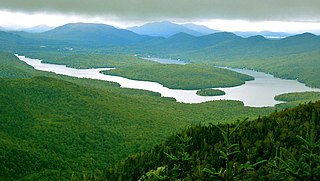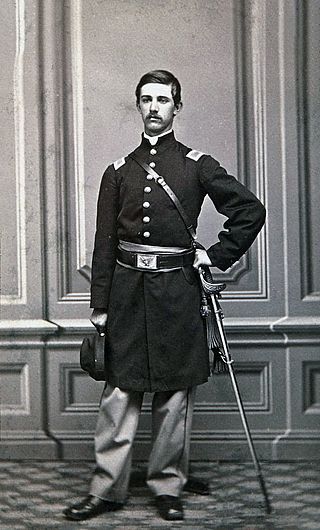Related Research Articles

Clinton County is a county in the north-easternmost corner of the state of New York, in the United States and bordered by the Canadian province of Quebec. It is the northeastern most county in New York. As of the 2020 United States Census, the population was 79,843. Its county seat is the city of Plattsburgh. The county lies just south of the border with the Canadian province of Quebec and to the west of the State of Vermont. The county is named for George Clinton, the first Governor of New York, who later was elected as Vice President. He had been a Founding Father who represented New York in the Continental Congress. Clinton County comprises the Plattsburgh, New York Micropolitan statistical area. The county is part of the North Country region of the state.

Franklin County is a county on the northern border of the U.S. state of New York. To the north across the Canada–United States border are the Canadian provinces of Quebec and Ontario, from east to west. As of the 2020 census, the county population was 47,555. Its county seat is Malone. The county is named in honor of United States Founding Father Benjamin Franklin. The county is part of the North Country region of the state.

Warren County is a county in the U.S. state of New York. As of the 2020 census, the population was 65,737. The county seat is Queensbury. The county was established in 1813 and is named in honor of General Joseph Warren, an American Revolutionary War hero of the Battle of Bunker Hill. The county is part of the Capital District region of the state.

The Adirondack Mountains are a massif of mountains in Northeastern New York which form a circular dome approximately 160 miles (260 km) wide and covering about 5,000 square miles (13,000 km2). The region contains more than 100 peaks, including Mount Marcy, which is the highest point in New York at 5,344 feet (1,629 m). The Adirondack High Peaks, a traditional list of 46 peaks over 4,000 feet (1,200 m), are popular hiking destinations. There are over 200 named lakes with the number of smaller lakes, ponds, and other bodies of water reaching over 3,000. Among the named lakes around the mountains are Lake George, Lake Placid, and Lake Tear of the Clouds. The region has over 1,200 miles (1,900 km) of river.

Columbia County is a county located in the north central portion of the U.S. state of Florida. As of the 2020 census, the population was 69,698, up from 67,531 at the 2010 census. Its county seat is Lake City.

Lake City is a city in and the county seat of Columbia County, Florida, United States. As of the 2020 census, the city's population was 12,329, up from 12,046 at the 2010 census. It is the principal city of the Lake City Micropolitan Statistical Area, composed of Columbia County, as well as a principal city of the Gainesville—Lake City, Florida Combined Statistical Area. Lake City is 60 miles west of Jacksonville.

North Elba is a town in Essex County, New York, United States. The population was 7,480 at the 2020 census.

Brighton is a town in Franklin County, New York, United States. The population was 1,435 at the 2010 census. It was named after Brighton, England, by early surveyors in the region.

Franklin is a town located in Franklin County, New York, United States. As of the 2010 census, the town had a population of 1,140.

Saranac Lake is a village in the state of New York, United States. As of the 2020 census, the population was 4,887, making it the largest community by population in the Adirondack Park. The village is named after Upper, Middle and Lower Saranac lakes, which are nearby.

The 54th Massachusetts Infantry Regiment was an infantry regiment that saw extensive service in the Union Army during the American Civil War. The unit was the second African-American regiment, following the 1st Kansas Colored Volunteer Infantry Regiment, organized in the Northern states during the Civil War. Authorized by the Emancipation Proclamation, the regiment consisted of African-American enlisted men commanded by white officers. The 54th Massachusetts was a major force in the pioneering of African American civil war regiments, with 150 all black regiments being raised after the raising of the 54th Massachusetts.

Edward "Ned" Needles Hallowell was an officer in the Union Army in the duration of the American Civil War, commanding the 54th Massachusetts Volunteer Infantry following the death of Colonel Robert Gould Shaw at the Second Battle of Fort Wagner in 1863.

Glory is a 1989 American historical war drama film directed by Edward Zwick about the 54th Massachusetts Infantry Regiment, one of the Union Army's earliest African-American regiments in the American Civil War. It stars Matthew Broderick as Colonel Robert Gould Shaw, the regiment's commanding officer, and Denzel Washington, Cary Elwes, and Morgan Freeman as fictional members of the 54th. The screenplay by Kevin Jarre was based on the books Lay This Laurel (1973) by Lincoln Kirstein and One Gallant Rush (1965) by Peter Burchard and the personal letters of Shaw. The film depicts the soldiers of the 54th from the formation of their regiment to their heroic actions at the Second Battle of Fort Wagner.

Paul Smith's College is a private college in Paul Smiths, New York. Paul Smith's College offers associate, bachelor's, and master's degrees. Its 14,000-acre campus is one of the largest college campuses in the world. As of 2023, approximately 600 students attend each year.

Paul Smith's Hotel, formally known as the Saint Regis House, was founded in 1859 by Apollos (Paul) Smith in the town of Brighton, Franklin County, New York, in what would become the village of Paul Smiths; it was one of the first wilderness resorts in Adirondacks. In its day it was the most fashionable of the many great Adirondack hotels, patronized by American presidents Grover Cleveland, Theodore Roosevelt and Calvin Coolidge, celebrities like P.T. Barnum, and the power elite of the latter half of the 19th century, such as E. H. Harriman and Whitelaw Reid. Smith died in 1912, but the hotel continued under his son, Phelps, until it burned down in 1930.

Stephen Atkins Swails was a soldier in the Union Army during the American Civil War. Although originally enlisting as a private, he was the first African-American soldier promoted to commissioned rank, as a line officer, in that conflict, as evidenced by the U.S. War Department's initial refusal of that promotion due to his "African descent."

Luis Fenellosa Emilio was a Captain in the 54th Massachusetts Volunteer Infantry, an American Civil War Union regiment.

Loon Lake is a hamlet and a lake in the northeastern region of Adirondack Park in the U.S. state of New York. The community is located on the east side of Loon Lake and 18 miles (29 km) northeast of Saranac Lake and 27 miles (43 km) north of Lake Placid.

Timbuctoo, New York, was a mid-19th century farming community of African-American homesteaders in the remote town of North Elba, New York. It was located in the vicinity of 44.22°N 73.99°W, near today's Lake Placid village, in the Adirondack Mountains of Upstate New York. Contrary to the information given out by donor Gerrit Smith, who said that the lots were in clusters, they were spread out over an area 40 miles (64 km) north to south, and 15 miles (24 km) east to west.
References
- ↑ Godine, A. (2023). The Black Woods: Pursuing Racial Justice on the Adirondack Frontier. Cornell University Press. ISBN 978-1501771682
- ↑ Svenson, S. (2017). Blacks in the Adirondacks: A History. Syracuse University Press. ISBN 978-0815610939
- ↑ Stager, C. (2023). For The Record: Uncovering the Stories of Black Pioneers. Adirondack Life. (February issue) https://www.adirondacklife.com/2023/02/13/uncovering-the-true-stories-of-black-pioneers-in-the-adirondacks/
- 1 2 3 4 Emilio, L.F. (1891). A Brave Black Regiment: The History of the Fifty-Fourth Regiment of Massachusetts Volunteer Infantry 1863-1865. CreateSpace Independent Publishing Platform. ISBN 978-1974169382.
- ↑ "Godine (2023)
- ↑ Svenson (2017)
- ↑ Stager (2023)
- ↑ Godine (2023)
- ↑ Godine (2023)
- ↑ Svenson(2017)
- ↑ Stager (2023)
- ↑ Forgotten Voices: Shooting In The Adirondack, Published in association with Charles Dickens by an unknown author in the periodical “All The Year Round” Sept 29, 1860
- ↑ Wardner, C.A. (author), and Allen, J.W. (compiler) (2010). Sunset on Adirondack Trails: The Memoirs of James Manchester Wardner. (Part 2, pp. 67-68). Graphics North. ISBN 978-0982950302
- ↑ Godine (2023)
- ↑ Svenson (2017)
- ↑ Stager (2023)
- ↑ Emilio (1891)
- ↑ Emilio (1891)
- ↑ Emilio (1891)
- ↑ Letter by J.P. Hatch (1864), available at https://battleofolustee.org/reports/hatch.htm
- ↑ Emilio (1891)
- ↑ Emilio (1891)
- ↑ Godine (2023)
- ↑ Stager (2023)
This article needs additional or more specific categories .(June 2024) |